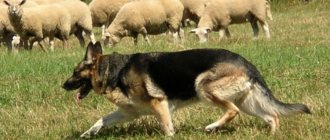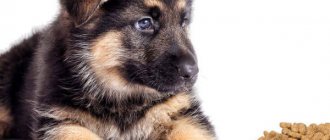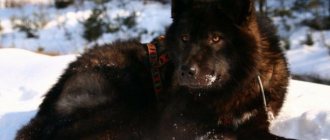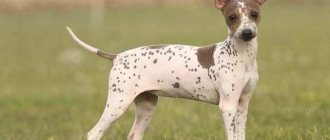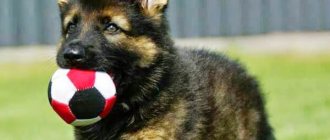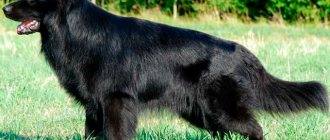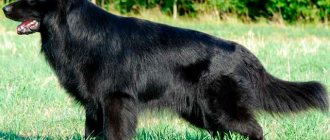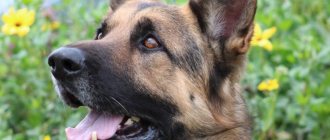The German Shepherd is a large and hardy dog, characterized by good hunting, fighting and guarding skills. Representatives of the breed are smart, easy to train and endlessly devoted to their owner. They are often used in their work by dog handlers, police officers, rescuers, military personnel and even doctors, but such pets are also popular among private breeders. When properly raised, they do not show aggression towards people and other animals.
The German Shepherd has good guarding skills.
History of the breed from the beginning to the present day
The Sheepdog as a separate breed was officially registered only in the 19th century, but in reality has a longer history. During archaeological excavations in Austria, the Czech Republic and Poland, it was found that pets with similar characteristics became companions of people around the 4th–7th centuries.
The ancestor of modern shepherd dogs is considered to be the small Indian wolf. These animals were domesticated in Asia. Initially, they were used to guard settlements and hunt. However, due to human migration, they found their way to Western Europe. Here they began to be used for grazing sheep and cattle.
The working qualities of these animals contributed to their spread. In the 18th century Germany became the breeding center of the breed. Because of this, the shepherd began to be called German. During this period, attempts were made to improve the animal's characteristics. At first we managed to get pets with large and medium builds. The first had long black or red fur, a gentle disposition and floppy ears, while the second, more aggressive, had a gray color, like their wild ancestors.
In the 19th century Shepherd dogs began to be crossed with other herding dogs. People tried to get non-aggressive and obedient pets with good protective qualities. In Germany, breeding work was carried out by cynologists Sparwasser and Wachsmuth, who crossed Thuringian and Wütenberg shepherds. Subsequently, dog handler M.E. von Stefanitz began improving the breed. The standards were finally formed by the end of the 19th century.
The qualities of the German Shepherd contributed to its spread.
In 1889, a breeder bought a puppy, which was the first to be entered into the stud book. This date is considered the time of the appearance of the breed. The first breed club was registered in 1909. At the same time, standards were described. World canine services recognized this breed only in 1923. After World War II, these shepherd dogs were on the verge of extinction, but thanks to the efforts of enthusiasts, their population was revived. The last adjustment to the standards was carried out in 1996.
Historical data
In order to trace the pedigree of various types of breeds, even if they became known already in the 19th century, and even more so in the 20th century, it is enough to rummage through special documents or use eyewitness information. As for the German Shepherd breed, not everything is so simple, since experts say that the ancestors of this breed should be sought much deeper.
Archaeological data obtained as a result of excavations in the territories of some European countries indicate that back in the 4th millennium BC there were dogs whose skeletons were very similar to the skeletons of modern shepherd dogs. According to experts, their ancestors are wild individuals who lived near the sites of ancient people, as a result of which they began to obey the will of man.
Scientists also suggest that already in those days primitive breeding work was carried out, as a result of which preference was given to strong and obedient individuals.
The small Indian wolf, which no longer exists in our time, increasingly moved away from its independent relatives, eventually acquiring the status of Bronze Age dogs. As time passed, humanity gradually developed, as a result of which the needs of all humanity changed. Despite this fact, farmers and pastoralists have always been tied to a specific area. As a result, four-legged companions began to master new functions. Throughout Europe, and especially in the Middle Ages, it was customary to breed Hofwarts. Translated from German, this means “guardian of the yard,” although dogs also performed other functions not related to real estate protection.
In those days, the area was simply teeming with predators, and domesticated livestock needed protection. In addition, already in those days there were many who wanted to profit from other people’s goods. Man could not cope with his responsibilities on his own, especially when he had to graze numerous herds. Therefore, man had to take advantage of the capabilities of yard dogs. Not all dog breeds could cope with the protection of numerous flocks, but only those that were distinguished by endurance and intelligence. The problem was also to select and train the animal. Such dogs were so valuable that in those days, for killing a dog that was herding flocks of livestock, the culprit faced death punishment.
According to experts, animals of the Medieval period, including those of later eras, were significantly different from modern representatives of various breeds. In those days, the main attention was paid not to the shape of the body, but to the mental abilities of the animal and its endurance. No less important was the “psychological portrait” of the dog, which was always next to the person. As a rule, the shepherds were isolated for a long time, throughout the entire season of keeping the animals, so the dogs were in contact exclusively with the shepherds all this time. And here the most important thing is that the dogs unquestioningly perform their functions. Moreover, the dogs were supposed to become real friends and companions for the shepherds.
By the end of the 17th century, the main characteristics of herding dog breeds began to appear. Two regional breeds have become widespread: the semi-long-haired Thuringian dogs with a curled tail and a fawn-gray color, as well as the long-haired Württemberg dogs with semi-erect ears, distinguished by a black or red color. These 2 breeds also differed in their behavior. If the former were considered very active animals and often barked loudly, then the latter were calmer and more resilient. Therefore, the breeders decided to join forces to develop a completely new breed of dog.
A lot of time passed and at the end of the 19th century the result of long and painstaking work was presented to the general public. In 1882, Baron von Knigge presented two of his pets at the Hanover Exhibition. Interest in the new breed arose with renewed vigor when the owners of the Hannau kennel showed off their impressive pair. Thanks to this couple, at least 2 dozen champions and winners of subsequent dog shows were born.
In 1891, it became known about the creation of the first club of German Shepherd lovers, although this organization, called “Philax,” did not exist for so long, and it was able to determine the breed standards in such a short period. On the German-French border, in the city of Karlsruhe, an exhibition took place, which is considered to be significant. The event was not anything extraordinary, but at the exhibition many saw a unique representative of the old-format breed. However, he did not take part in the exhibition.
Hector von Lyrkenheit did not do anything supernatural, but only entertained the audience, demonstrating the shepherding skills of his pet. At that very moment, two friends happened to be nearby, who in their free time practiced breeding German Shepherds. They immediately noted that the dog’s external characteristics were not inferior to his shepherding skills. The owner refused for a long time to provide his dog for breeding work.
Since friends believed that they had got the ideal representative of this breed, they included him in the list of breeding work at number one. From that moment on, they began to look for a bitch for the dog who would have similar characteristics to him. It took very little time, and the couple produced offspring worthy of imitation of this breed. As a rule, even modern successors of this family have a purebred line associated with this “ideal German”.
Claude von Boxberg is considered another famous representative of this breed, since he took part in the 1925 international exhibition and won a landslide victory. This moment is considered the factor that marked the beginning of a new breeding line.
In 1936, when Max von Stephanitz died, members of the National Socialist Party insisted that the breed should not appear outside Germany. It is believed that the events of this period were the cause of his death, as national patriots threatened this man, intending to send him to a concentration camp. During the Second World War, many animals were destroyed, including nurseries for their breeding. Nobody cared about the purebredness of the surviving individuals. In fact, it was possible to preserve several purebred individuals, and in the post-war years there were enthusiasts who set to work to restore this unique breed. Already in 1946, exhibitions continued, and after another 5 years a new winner appeared, who became the founder of the modern lines of purebred German Shepherd.
The German Shepherd Owners' Union was created back in April 1899. The activities of the leaders of this Union were aimed at maintaining the purity of blood, confirming this with relevant documents. At the same time, it was practiced to encourage breeders who developed the working characteristics of the breed. This organization has survived to this day. In May 1968, an international association began its work, which is known today as , which has brought under its “wing” 89 national unions from 82 countries of the world.
GERMAN SHEPHERD – INTERESTING FACTS
General information about the breed
Shepherds are large, hardy and intelligent animals:
- They can cope equally well with official tasks and be companions for families.
- They get along well with people of all ages, incl. with kids.
- Suitable for both home and aviary keeping.
- They need regular physical activity and interaction with people for socialization.
- Thanks to natural selection and then targeted crossbreeding with other herding dogs, they have good health and are able to survive even in harsh weather conditions.
Lifespan
The average lifespan of a Shepherd is approximately 9–13 years. Animals over 7 years old require careful care and health monitoring. Many diseases appear in old age. These disorders can cause a reduction in your pet's life expectancy.
The maximum lifespan of shepherd dogs is 13 years.
Breed group
According to the FCI, this shepherd belongs to group 1 – cattle breeding and herding. The English Kennel Club classifies the breed as Pastoral. However, the American Kennel Club classifies it as a Harding breed.
How much does a puppy cost?
The price of puppies that fully meet the standards and are potential winners of exhibitions exceeds 1 thousand dollars. Purebred shepherd dogs with good guard and service characteristics, as well as animals purchased for home keeping, but not having a “champion” pedigree, cost from 25 to 65 thousand rubles.
Health BUT, disease prevention
Dogs of this breed live 9-13 years, this period can be extended by paying attention to the health of the animal: you should visit the veterinarian two to three times a year.
Forced inbreeding and historical difficulties in maintaining the purity of the breed could not but lead to a predisposition to some serious diseases. Many appear during the animal’s growth: intermittent lameness; diabetes; lack of growth hormones; pyoderma.
With age, the list of diseases characteristic of the breed expands: dysplasia, spinal problems, and arthritis are often diagnosed. Often dogs suffer from insufficient functioning of the pancreas and heart disease (mitral valve dysplasia).
If the quality of care is insufficient, under the influence of unfavorable factors, serious infectious diseases of the eyes and ears, skin and stomach diseases can occur.
If your dog’s health worsens, you should immediately show it to a veterinarian so that treatment can be prescribed as early as possible. You need to especially carefully monitor the dog’s well-being when it reaches 7 years of age.
Exterior of a German Shepherd
A purebred shepherd must meet breed standards. It is important that the ratio of weight and height is proportional. A healthy animal has a strong physique and developed muscles.
Head and ears
The shepherd's head is quite large. According to the standard, its length is approximately 40% of the dog’s height at the withers. It has a moderate wedge shape. The forehead is slightly rounded and convex. The ratio of the lengths of the facial and cranial parts is approximately the same. The transition between them is smooth. Transferred straight. The shepherd's ears are large and set high. The shells are triangular in shape, rounded at the top and turned forward. Ear cartilage is elastic. According to the standard, creases and bends are not allowed.
The head and ears of the shepherd are very large, the forehead is convex.
Dog eyes
The eyes are not protruding, medium in size, oval in shape and set slightly obliquely. They are covered by thick eyelids. The iris is dark brown.
Nose
The nose is medium in size and does not have a clear dividing line. Its shape is classic. According to the standard, it should be black. The nasal passages are clearly defined.
Teeth and jaws
The shepherd dog has a scissor bite. The lower and upper jaws are equally well developed, strong and powerful. The bite force is approximately 315 kg per 1 sq. cm. This is approximately 56 atm. The teeth are quite large and strong. The enamel is white.
Shepherd dogs are characterized by a complete dental formula. The lips are dark brown or black in color and fit tightly to the jaw.
Neck and torso
The animal's neck is approximately equal in length to its head. She is muscular and agile. There is a moderate slope. The withers are strong and clearly defined.
The animal's neck is mobile and muscular.
The line of the back has a smooth curve from the withers to the croup. The chest is deep and wide, normally has a slightly elongated shape. The back is muscular and wide. The croup is sloping and blends smoothly into the base of the tail. The chest is round and deep. The tail is long and slightly curved, normally carried down.
Limbs
The animal's muscles are strong and muscular. The front legs are straight and parallel. In this case, the humerus and shoulder blades have the same length and are connected at right angles. The hind legs are straight and parallel, but slightly set back. The paws are compact in size. The pads are quite elastic and hard. The fingers are crowned with strong claws of medium length.
Wool
The spinous cover is quite hard and dense. The hairs are straight. There are long featherings on the back of the thighs, tail and neck. The undercoat is thick and dense. It provides good thermal insulation and protects the animal even in severe frosts.
Color
3 types of colors are allowed: saddleback, black and zoned.
German Shepherds come in several different colors.
The first one is the most common. Approximately 90% of individuals of this breed are born with it. Black-backed animals have a black spot on their back that is shaped like the letter V. The fur on the top of the tail and sides is brownish-brown. The fur on the chest, neck and paws is of a lighter tone. For dogs of this color, the standard allows the presence of hairs of gray, fawn and brown shades. The presence of a black mask on the face is important.
Approximately 3–5% of shepherd dogs are born with black coloring. The color should be uniform. The inclusion of other shades is not permitted. In addition, such animals should have black nose and paw pads.
In shepherd dogs with zonal coloring, the hair on the face, tail and back is more intense, and on the paws and sides the hair is one or more shades lighter.
All shades from chocolate brown to fawn are allowed.
Dimensions and weight
The Shepherd is a medium-sized animal. Its height at the withers is 55–65 cm, and its weight is 22–40 kg.
Disqualifying faults
If there are any deviations from the standard, the animal is excluded from participation in exhibitions and further breeding work.
All defects are conventionally divided into physical and mental.
Physical defects include ear cartilage that is too soft.
The first category includes:
- Absence of a mask on the face in dogs with black coat color.
- The ear cartilages are too soft, which is why they do not stand upright in a puppy older than 6 months.
- Light coloring of the irises.
- Lower jaw with weakly defined chin.
- Wide or close set eyes.
- Shortened neck.
- Saggy lips.
- Incomplete set of teeth.
- The head is disproportionately large or small in relation to the body.
- Gray lip color.
- Neck extension too high or low.
- Flattened or sagging back.
- Flat, muscular or too short withers.
- Barrel or narrow chest.
- The tail is set high and not saber-shaped.
- Shortened sternum.
- Sagging or lean belly.
- Short shoulder blades and curved forearms.
- Clubfoot or markings.
- Light claws.
- Elongated mouth.
- Narrow hips with underdeveloped muscles.
- Incorrect alignment of joints.
- Short or too long shin.
- Weak push of the hind legs.
- Insufficient extension of the forelimbs.
- Short step.
- Lack of stamina.
- Crooked bite.
In addition, various genetic abnormalities are considered physical abnormalities, incl. dead tail, albinism, cryptorchidism, mild sexual dimorphism, joint dysplasia, etc.
Mental defects often lead to the disqualification of an animal. Deviations in the functioning of the nervous system include fear of loud sounds, cowardly-evil behavior, excessive aggressiveness, cowardice, etc.
Breed characteristics
Each shepherd has its own character traits. At the same time, there are common features that are present in all animals of this breed. Shepherd dogs have not only good physical properties, but also a developed brain. A properly raised animal has a balanced and calm disposition. This dog is hardworking and ready to complete even difficult tasks.
Purpose
Shepherds are classified as service dogs. They are strong, have a good sense of smell and are easy to train, so they can be taught to search for people and drugs. Because of this, they are often used in their work by police officers, rescuers, customs officers, etc. With proper upbringing, the animal follows the commands of not only the trainer, but also his colleagues.
This breed is often used for protection. The shepherd is devoted to its owner and tries to protect him from any dangers. Shepherd dogs also cope well with herding duties. They are able to guide the herd in the right direction, helping the drivers. With the necessary training, the shepherd performs the functions of a guide.
Intelligence and aggression
Shepherds are one of the three smartest dogs. These animals have a large brain volume and are characterized by hard work. For a shepherd, training is a great joy. With the right approach, she willingly learns new tricks and commands. At the same time, this dog is emotionally attached to its owner and needs his encouragement to perform tricks correctly and reprimand when necessary.
Animals are aggressive towards strangers.
The average animal can master about 20–30 commands. However, especially talented individuals are able to remember more than 50 tricks. Although these mentally healthy, moderately aggressive animals are wary of strangers, if properly trained they will never attack a person without a command.
Dog character
The Shepherd has a complex character. She treats people and animals with whom she grew up well, but at the same time she perceives only one person as her owner. Intuitively, the dog senses his mood. By temperament, most shepherd dogs are choleric. These animals control their emotions well when they are on duty; they happily play and follow their owner’s commands. At the same time, shepherd dogs do not tolerate loneliness well.
If your pet doesn't get enough attention, he may become bored or even depressed. This animal has strong protective instincts, so it needs to be walked on a thick leash and muzzle.
The Shepherd does not show aggression without a reason, but sudden movements of strangers can provoke it.
Shepherd dog interaction with children
Shepherds are extremely intelligent and are well aware that a child is not dangerous. These dogs often take on the role of nanny for small children, protecting them from any dangers. Joint outdoor games bring great joy to the animal. At the same time, you should not leave such a large and strong pet alone with small children. A shepherd dog that gets too playful can accidentally harm a child.
Shepherds do not pose a danger to small children.
Compatibility with other animals
A shepherd dog is good with other dogs only if it has grown up with them. When there is already an adult “German” in the house, introducing her to a recently purchased puppy can be difficult. At the same time, shepherd dogs are often quite loyal to cats and birds.
Many owners note that some adults do not show aggression, even when a kitten or parrot that has just arrived in the house begins to play with its tail or pull at its ears. When irritated, a shepherd may begin to bark, but the risk of it attacking another pet is minimal. Moreover, without proper upbringing, she will react sharply to strange cats and dogs when walking.
Character
Those who were the owner of a German shepherd rarely get dogs of other breeds. There is an explanation for this. The fact is that a representative of this breed is not only efficient, but also very smart. His intellectual abilities are amazing.
This dog always understands what mood its owner is in, and he can also adapt to it. It is well trained, but is willful. Every smart dog needs proper and consistent training.
If you don’t teach her the rules of behavior from childhood, she will become angry and difficult to control. The German Shepherd is very self-confident, knows that it is smart and strong, so it often becomes self-centered. Quite proud, prone to independence. But, despite all these shortcomings, she is affectionate and responsible.
The love of this breed for its owners is limitless. He is filled with joy when he looks at them. When household members pet or kiss the dog, he rejoices. She never skimps on her feelings and strives to demonstrate her love and tenderness to her loved ones. In everyday life he is very affectionate. Can sit next to people for hours. Doesn't like loneliness or isolation. Prefers to be the center of attention.
Naturally strong and resilient. He is prone to competition, because he knows his own worth and can challenge any opponent. He is ready to fight for the attention and love of his owner by any means. If he gets another dog, the shepherd will bully it, maybe even bite it. It is important to pay attention to this in time and correct her behavior.
It is a mistake to think that a representative of this breed is exclusively a “working” pet. Yes, he will faithfully guard his household and the territory in which they all live, but this does not prevent him from showing tenderness and affection. It's cute to watch a large guard dog roll over on its back in front of a person, inviting him to pet him.
Note! When a dog bares its belly, it shows its trust in you. This part of her body is the most vulnerable, therefore, showing it, she says: “Man, I’m not afraid, but I love you, you can stroke me.”
Thanks to its full range of positive character traits, the German Shepherd is an ideal family dog. She serves her family faithfully, looks after the children responsibly, and loves to play and have fun. But you should not expect that such a dog will be friendly with every person, especially with strangers.
Do not forget that, first of all, this is a guard dog that protects and protects the members of its pack. There is no point in teaching her how to guard, since she herself knows and feels how to do it.
This is why the German Shepherd will express aggression towards every person standing outside its territory. But as soon as the owner appears and greets the guest, the dog’s attitude towards him will immediately change.
He will understand that since the owner is friendly with the stranger, then he does not pose a threat. She always relies on him, but sometimes she becomes obstinate and decides on her own. By nature he is merciful. Protects those who are weaker than him. Never gets involved in conflict without reason. Seeks the owner's approval. Loves sports and active recreation.
Difference between male and female
Shepherd dogs have fairly well-defined sexual dimorphism. Males are approximately 10–20% larger than females. Males have a richer and brighter coat color. Males emit a specific unpleasant odor, while females have almost no smell. Females are more intelligent and easier to train. In addition, they are more affectionate towards strangers and other animals.
Bitches are characterized by a soft disposition. Moreover, during pregnancy and immediately after birth, they can growl, trying to protect the puppies.
Males are more willful and prone to dominance, showing aggression towards strangers and animals. They periodically disobey their owner, testing his strength.
Raising and training a German Shepherd
The shepherd is quite smart and easy to train. Her upbringing cannot be left to chance, because... in this case, there is a high probability that the animal will acquire many bad habits or become aggressive. The puppy spends the first 2 months with a female dog, who helps him socialize.
The German Shepherd is easy to educate and train.
At 2–4 months the animal is transferred to a new owner. During this period, the dog begins to get acquainted with the outside world. It is recommended to take her outside only in your arms and introduce her to other people, animals, and new smells. It will be useful to accustom your pet to traveling on public transport. You can start introducing him to the collar and leash.
The owner should help the puppy learn basic commands at home. During this period, the animal owner should be as patient as possible. Any correct actions by your pet should be rewarded. You should not yell at or hit the shepherd.
Starting from 6–7 months of age, you can begin taking a course of disciplinary and then general training. By this time, the pet and the owner should have built a trusting relationship.
The animal must perceive the person as a leader. To properly raise an animal, you should contact a dog handler.
History of the origin of smooth-haired Germans
The first mentions of short-haired German Shepherds were found in documents from the 7th century. By the 19th century, they were widespread in what is now Germany, where the dogs were used as herding dogs. The breed owes its modern appearance to Friedrich von Stefanitz, who was engaged in selection and brought the shorthaired Germans to perfection. At the beginning of the 20th century, the Union of Shepherd Dog Owners was created, within which a lot of work was done to select the best representatives and develop a standard. Animals from herding turned into service animals - pets were given to the army and police.
Care and maintenance of the German Shepherd
It is extremely important to provide the shepherd with the necessary conditions of detention and care, because... The psychological and physical health of the animal depends on this. These are quite large dogs, so for normal growth and development, as well as further life, they require good nutrition.
Rules of care
Shepherds shed almost all year round, so their coat requires special care. It is necessary to accustom the animal to regular brushing from puppyhood.
The shepherd's coat needs to be brushed regularly.
To do this, you can use special brushes that do not injure the skin. It is enough to carry out this procedure once every 2–3 days. However, during the period of the most intense shedding, which occurs at the beginning of spring and autumn, combing is performed every day. This is especially important if the animal lives in the house.
You need to bathe your dog no more than 2-3 times a year. In this case, it is worth using special shampoos for wire-haired breeds.
If the animal lives in an apartment or house, you need to trim its claws once a month.
Dog hygiene
It is important to pay special attention to the animal's eyes, removing any discharge as it appears. 1-2 times a week it is necessary to clean the animal’s ears using damp cotton swabs, as well as the teeth (to prevent the formation of plaque and tartar).
Walk
Puppies under 3 months old, i.e. Before vaccination, walking on the street is prohibited. At this age, their immunity is weak, so they are easily affected by various infections. Dogs over 3 months old should be allowed out for 30 minutes a day. This time should be spent beneficially for the animal, so that it can warm up and get the necessary physical activity. Starting from the 4th month of life, the puppy is walked for approximately 40–60 minutes. For animals older than 6 months, this is done 2 times a day for 2 hours.
It is not recommended to walk small puppies outside.
It is important that the dog, until the age of six months, does not jump over obstacles on its own, does not go down or climb stairs, because... this can negatively affect the formation of the spine and the entire skeleton. You should walk your pet during daylight hours in specially designated areas. It is imperative to put a collar, muzzle and leash on the animal.
Sleeping area
The arrangement of a sleeping place for a dog should be approached with maximum attention. This area should be comfortable, without drafts, and large enough so that the animal does not feel constrained. You can place a lounger in the sleeping area made of natural fabric that does not accumulate static electricity and does not cause skin irritation.
German food
The shepherd dog can be given special premium food that contains a sufficient amount of vitamins and minerals, or natural products. Puppies eat 5-6 times a day, and adults - 2 times a day. With natural nutrition, the dog is given high-calorie and nutritious food. The basis of the diet should be foods high in protein.
Especially useful for shepherds:
- chicken;
- beef;
- rabbit meat;
- low-fat cottage cheese;
- raw fruits and vegetables;
- rice, buckwheat and oatmeal, etc.
The German Shepherd needs to be fed special food.
Is it worth keeping outside?
A puppy can be kept in an indoor enclosure from 3–4 months only if it has lived in such conditions with a female dog since birth. Otherwise, the dog should be gradually accustomed to its new home. A shepherd can live outside even in winter. At the same time, it is important that the enclosure be equipped with a dry, warm box where the animal will hide in severe frosts.
How to feed a German
When setting up the puppy's feeding area, the bowl should be placed on a slight elevation so that it is at the level of the animal's chest, this will help to correctly shape the dog's exterior.
It is allowed to feed the animal with high-quality natural food or premium balanced dry food.
German Shepherd diet (natural food):
- protein – 70%. Meat is healthy (beef, lamb, chicken, turkey, duck, goose), it is given raw without bones and skin. Also allowed protein products include cottage cheese, offal (stomachs, heart can be given often, and liver - less often);
- carbohydrates – cereals, vegetables, unsweetened fruits;
- fats. Vegetable oil is added to the diet.
Breeding German Shepherds
In females of this breed, the first heat occurs at 8–10 months. It lasts about 20–22 days. However, a female can only be allowed to mate for the first time at 20–25 months. A suitable male dog should be found 2 weeks before. It is advisable to draw up a written agreement and visit a veterinarian to rule out bacterial infections in the future parents.
The 13th–15th day of estrus is considered the most favorable for mating. During this time, the bitch is brought to the dog’s house. They may need help.
Repeated mating is carried out after 2 days. Pregnancy lasts 61–65 days. There are 8–10 puppies in a litter.
Dog health
Dogs that are bred as pets, i.e. without pedigree, they are characterized by good health. However, purebred “Germans” often have sensitive digestion and are prone to allergies and stomach upsets. In addition, they are often susceptible to ear diseases and vision problems. The predisposition to them is due to frequent closely related matings of show dogs. Thus, the better the pedigree, the higher the risk that the animal has a disorder.
German Shepherds are prone to vision problems.
Are there genetic defects?
Shepherds have a genetic predisposition to pathologies such as:
- degenerative myelopathy;
- benign and malignant tumors;
- diabetes;
- pyoderma;
- hip dysplasia;
- epilepsy;
- hormonal imbalances.
Reproductive health
The best age for the first pregnancy is 2–4 years. If the first mating occurs earlier or later, there is a high probability of the birth of offspring with genetic defects. Males can be bred starting at 18 months. It is important that the first mating is with an experienced bitch. If the pet is not planned to be used for breeding, it is better to have it spayed or neutered. The optimal period for the operation is in the 1st–3rd year of life.
The best age for shepherd dogs to become pregnant and give birth is 2-4 years.
Disease Prevention
Diseases of shepherd dogs can be divided into genetic and infectious. Pathologies belonging to the first category are difficult to control. They often cause the culling of puppies and the euthanasia of adult animals. To prevent infectious diseases, it is necessary to carry out vaccinations in a timely manner. In addition, it is necessary to provide the pet with good living conditions and quality food.
How to choose the right puppy
All the characteristics of the animal described above are inherent in individuals whose pedigree is officially confirmed by documents. Individuals that are not of pure blood (half-breeds) may also have a similar external and psychological portrait, but this category of German Shepherds represents completely different dogs.
Prospective owners who are interested in getting a specific breed of dog should look for puppies from trusted individuals and kennels that have an excellent reputation. Only in such conditions can you purchase a puppy that has no breed defects. It is very important that the future pet has a stable psyche, which is typical for purebred individuals.
As a general rule, responsible breeders will not sell puppies under a minimum of 8 weeks of age. By the 2nd month of life, puppies are already confidently standing on their paws, responding to their name and are ready for the training process.
If the future pet is planned to be used to participate in exhibition shows, then the main selection criteria come down to its health and friendliness. The fact that the puppy is absolutely healthy can be evidenced by its playful behavior, clean eyes, nose, and ears. In addition, the puppy should have an excellent appetite, an elastic belly without signs of bloating, and shiny coat. A German Shepherd puppy should behave calmly around people and not show aggression if someone wants to approach him.
It would be nice if the future owner of the puppy “gets acquainted” with its parents. In this case, a complete picture of the hereditary traits of the future pet can be formed. It won’t hurt to see the conditions in which the puppy and its parents are kept. If their space is clean, has quality food, and has a sufficient supply of toys, all of these factors indicate that the breeders are serious people. Plus, the future pet must have all the necessary vaccinations.
Advantages and disadvantages
Like any other breed, the shepherd has advantages and disadvantages that must be taken into account when planning to purchase such a pet.
The positive qualities of these dogs include:
- endurance;
- high intellectual properties;
- ease of training;
- friendliness;
- devotion to the owner;
- moderate aggressiveness.
Endurance and friendliness are the advantages of the breed.
The disadvantages of such pets include their hyperactivity and high demands on communication with people. In addition, these animals shed heavily and are not suitable for keeping in small apartments. Without proper upbringing, such a pet can pose a danger to both the owner and strangers.
Advantages and disadvantages of the breed
The advantages include:
- high versatility. The German Shepherd can be a good watchman, protector, and companion;
- the dog is highly trainable and endowed with good intelligence;
- devoted to the owner.
All disadvantages are relative:
- The animal is highly active. With an active dog, you will have to walk at least two hours a day, but how much this can be considered a disadvantage, everyone decides for himself
- the animal is distrustful of strangers, therefore, it will also be distrustful of visiting guests;
- has a good appetite, which, given its size, will lead to high food costs;
- in puppyhood and adolescence it can chew and spoil things. But this deficiency is corrected by education. Furniture, wires, shoes will protect the toys available to the dog.
- There should be no heat sources near the dog's bedding.
If the dog receives natural food, the ratio of protein and fiber in the diet must be strictly observed. Water must always be available and fresh.

